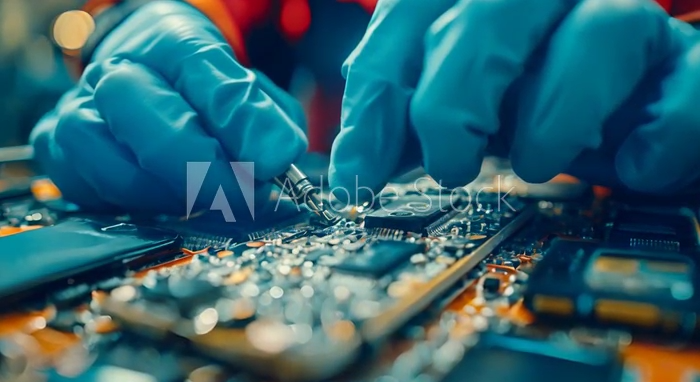In today’s digital age, electronics power nearly every aspect of our lives—from smartphones and laptops to smart cars and medical devices. At the heart of these powerful devices lies one of the most critical components of modern electronics: the printed circuit board (PCB). The image above perfectly captures a behind-the-scenes glimpse into the intricate process of circuit board assembly, where skilled technicians, wearing protective gloves, work with extreme precision to place and connect tiny electronic components.
What Is a Printed Circuit Board (PCB)?
A printed circuit board (PCB) is essentially the backbone of any electronic device. It serves as the foundation for mounting and interconnecting various components such as microchips, resistors, capacitors, and transistors. The components are soldered onto the board, allowing electrical currents to flow through conductive pathways etched into its surface. These boards come in various layers and complexities, depending on the application—from single-layer boards in toys to multi-layer boards in aerospace systems.
Zooming Into the Image: A Closer Look
This image beautifully illustrates the micro-level detail of circuit board assembly. The technician’s gloved hands emphasize the need for a sterile and contaminant-free work environment. Additionally, the use of fine-tipped tweezers suggests the handling of delicate surface-mount devices (SMDs) or integrated circuits (ICs), which are fundamental to modern electronics due to their compact size and efficiency.
The background glow and depth of field also suggest a high-tech environment, likely a cleanroom or a specialized lab where precision matters above all else. Such controlled environments are crucial because even a small particle of dust can compromise a device’s functionality or lifespan.
Why Cleanroom Practices and Gloves Are Essential
It’s important to understand why the technician is wearing gloves. Human skin naturally produces oils and sheds tiny particles that can interfere with delicate components. Therefore, gloves not only protect the technician but also ensure the sensitive electronics remain free from static discharge, contamination, or corrosion.
Moreover, the use of anti-static gloves is a standard practice in electronics manufacturing facilities. These gloves prevent the buildup of electrostatic charge that could potentially damage fragile microelectronics.
The Role of Hand Assembly in a Largely Automated Industry
While much of the electronics manufacturing process is automated today—thanks to robotic pick-and-place machines and automated soldering systems—certain steps still require human expertise. This is especially true in prototyping, quality control, and low-volume production runs. For example, soldering specific components, repairing manufacturing defects, or installing custom parts often demands a technician’s steady hand and sharp eye.
Furthermore, technicians may manually inspect boards for visual defects, perform functional testing, and fine-tune parts during assembly. Therefore, despite automation, the human element remains irreplaceable in ensuring product quality and reliability.
Industries That Rely on High-Precision Circuit Boards
From aerospace and automotive to consumer electronics and telecommunications, circuit board assembly is a foundational process in virtually every tech-driven industry. In medical devices, for example, ultra-precise circuit boards are used in life-saving equipment like pacemakers and diagnostic machines. Similarly, in defense systems, highly durable and accurate PCBs are vital for mission-critical applications.
Thus, the expertise depicted in this image extends far beyond what meets the eye. It represents the meticulous craftsmanship behind every electronic innovation.
Why This Matters in the Bigger Picture
Understanding how electronics are built allows us to better appreciate the technology we use every day. More importantly, it highlights the importance of skilled labor, clean environments, and cutting-edge tools in delivering the high-quality devices we often take for granted.
Additionally, as electronics continue to get smaller, faster, and more powerful, the demand for precise circuit board assembly will only increase. Therefore, this image does not just reflect the present—it gives us a glimpse into the future of technology manufacturing.
Conclusion
In conclusion, this detailed image of gloved hands assembling a circuit board is more than just a visual—it tells a story of precision engineering, quality control, and technological advancement. Whether it’s for a smartphone, a satellite, or a medical implant, the accuracy and care shown here are the foundation of the digital innovations shaping our world.
So the next time you power up your device, take a moment to appreciate the countless hours of expert craftsmanship and microscopic precision that go into every circuit board—just like the one shown in this captivating image.


